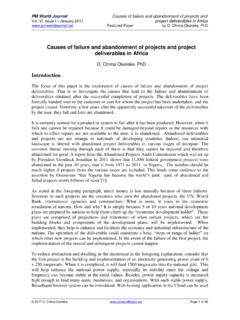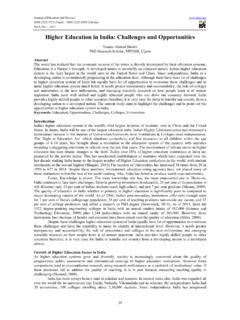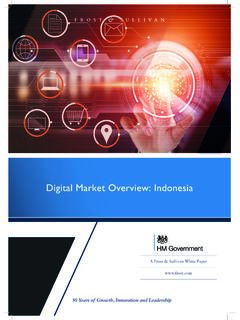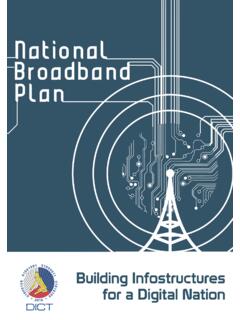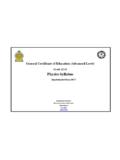Transcription of TECHNOLOGY INTEGRATION: A RESEARCH-BASED …
1 TECHNOLOGY INTEGRATION: A RESEARCH-BASED PROFESSIONAL DEVELOPMENT PROGRAM A thesis submitted in partial fulfillment of the requirements for the degree of Masters of Education By TORI ROSE FAULDER Middle Childhood Education, Mount Vernon Nazarene University, 2005 2011 Cedarville University iii ABSTRACT Faulder, Tori R. , Education Department, Cedarville University, 2011. TECHNOLOGY Integration: A RESEARCH-BASED Professional Development Program This RESEARCH-BASED thesis project explains the governmental acts and policies, investors, and other stakeholders who have worked to promote, question, and explore the use of information and communication technologies (ICT) in the classroom.
2 Research suggests that best-practice ICT integration requires using ICT alongside constructivist pedagogy. However, ICT integration is a complex phenomenon involving a significant number of factors. Teachers have often taken the blame for a failure to effectively integrate ICT in their classrooms due to their integral role in effective integration. This research project attempts to ensure that teachers will be equipped, empowered, and encouraged to include ICT in their instructional repertoires through the development of a RESEARCH-BASED professional development program. While this professional development program will only address the teacher factors involved in ICT integration, it is an essential step toward effective integration.
3 Iv TABLE OF CONTENTS I. Definition of Statement of Scope of the Study and Significance of the Methods of II. PLENARY LITERATURE Governmental Policy and History of ICT in Promises of ICT Current Utilization of Integral Role of the Professional v III. PROFESSIONAL DEVELOPMENT Phase One: School Phase Two: Training Phase Three: Non- and Limited-Use Phase Four: Increasing Classroom Phase Five: IV. V. VI. Appendix I: School Culture and Current Use Appendix II: Belief Meets Action vi ACKNOWLEDGEMENTS Though in today s society it often seems clich , I would like to thank the Lord for his perfect hand in my life.
4 I say this with the utmost reverence for who He is and with a thankful heart for his grace, mercy, and provision. I would also like to thank my family and friends for their patience and support throughout my life, and especially during the time that was invested in reaching this point in my professional life. Thank you to my colleagues who have been immensely supportive and caring during the time I spent working on this project. Finally, thank you to the many professors at Cedarville University who helped to prepare me for what undertaking this thesis would entail, especially Dr. Runyan, who so willingly offered his time and guidance throughout the final stages of this thesis project.
5 1 I. INTRODUCTION Various components of Information and Communication TECHNOLOGY (ICT) have increased dramatically in number and accessibility for the average school across the United States over the past two decades (Bebell, Russell, & O Dwyer, 2004). Given the vast promises of ICT to reform and enhance the educational system in the United States (Ayas, 2006), initiatives handed down from federal and state governments ( Department of Education, 2004), and significant investments in hardware and software to equip classrooms (Bebell, et. al., 2004), we would expect to see significant usage of these technologies in classrooms on a daily basis (Casey, 2008).
6 However, research identifies that ICT is only a marginal component in the education of the vast majority of the nation s students; and when it is used, it is not used in a way that fulfills its promise to enhance best practice teaching methods (Cuban, Kirkpatrick, & Peck, 2001). Across the nation a generation of digital natives is being raised up immersed in the world of ICT (Tondeur, Devos, Van Houtte, Van Braak, & Valcke, 2009). They live lives hooked up to various forms of ICT and other technologies that enhance, and sometimes even create, their daily lives, entertainment outlets, social connections, and planned future endeavors.
7 Information and Communication Technologies have significantly changed the operations of nearly every sector of the United States economy except the school system (Loveless, 1996; Keengwe, Onchwari, & Wachira, 2008b). Schools have been accused of being entrenched in the Industrial Age, while the rest of the world moves forward into the Information Age, leaving our students behind (Hopson, Simms, & Knezek, 2001-2002; Lunenberg, 1998). Thus, the question remains: Are 2 schools in the United States equipping their students for their futures using the best tools and practices available to them? Many reasons, ranging from hardware and software availability to teacher reticence, have been cited for this disparity in the availability and utilization of Information and Communication TECHNOLOGY (Groff & Mouza, 2008).
8 As availability of resources has increased with limited change in their usage, teachers seem to have become the scapegoat for the failure of ICT to live up to its promises (Ferneding, 2003). Accusations of a lack of creativity and innovativeness among teachers (Kurt, 2010), limited technological skills among these digital immigrants (Keengwe & Anyanwu, 2007), and unwillingness to adopt constructivist teaching methods (Prensky, 2008) are among the reasons cited for teachers failing to integrate TECHNOLOGY into their repertoire of teaching practices in order to develop, deliver, and enhance their curriculum. Although research would suggest that teachers are increasingly using TECHNOLOGY in their daily lives and for other professional endeavors, it also supports the claim that ICT use for instructional purposes is limited (Bebell, et.)
9 Al., 2004). Recent research identifies that this lack of integration is the result of a failure to equip and empower teachers to utilize ICT in a meaningful way in their classrooms. Higher education, prompted by standards handed down from government licensing, has attempted to implement TECHNOLOGY instruction into its teacher preparation programs with the hope of rectifying this disparity between personal and instructional use of computers by their teacher candidates (Pasco & Adcock, 2007). Despite these efforts, there is a lack of transference between learning the techniques involved in ICT integration and actually implementing them into the daily activities of the classroom (Kagan, 1992).
10 3 In addition to these new inductees, a number of veteran teachers remain in the classroom contributing their knowledge of teaching and learning to the field of education. Many of these veteran teachers graduated from teacher candidate programs long before new initiatives to equip teachers to use ICT in their classrooms were developed and initiated in institutions of higher learning. If the investments in ICT are to be put to effective use in the classroom, it is imperative that all teachers be equipped, empowered, and encouraged to use these technologies in their classrooms (Keengwe & Anyanwu, 2007). In attempting to increase ICT integration for instructional purposes, it is essential to consider the invaluable role of the classroom teacher.










